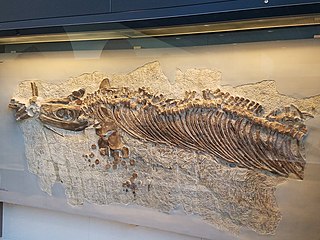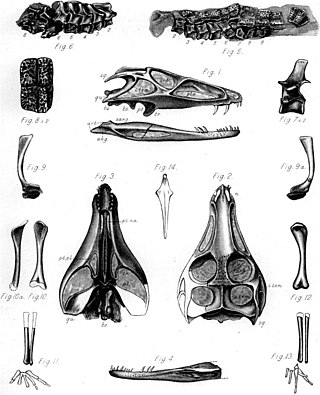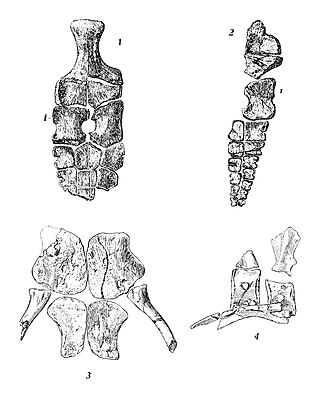
Herrerasauridae is a family of carnivorous dinosaurs, possibly basal to either theropods or even all of saurischians, or even their own branching from Dracohors, separate from Dinosauria altogether. They are among the oldest known dinosaurs, first appearing in the fossil record around 233.23 million years ago, before becoming extinct by the end of the Carnian stage. Herrerasaurids were relatively small-sized dinosaurs, normally no more than 4 metres (13 ft) long, although the holotype specimen of "Frenguellisaurus ischigualastensis" is thought to have reached around 6 meters long. The best known representatives of this group are from South America, where they were first discovered in the 1930s in relation to Staurikosaurus and 1960s in relation to Herrerasaurus. A nearly complete skeleton of Herrerasaurus ischigualastensis was discovered in the Ischigualasto Formation in San Juan, Argentina, in 1988. Less complete possible herrerasaurids have been found in North America, and they may have inhabited other continents as well.

Shonisaurus is a genus of very large ichthyosaurs. At least 37 incomplete fossil specimens of the marine reptile have been found in the Luning Formation of Nevada, USA. This formation dates to the late Carnian age of the late Triassic period, about 237–227 million years ago.

Chindesaurus is an extinct genus of basal saurischian dinosaur from the Late Triassic of the southwestern United States. It is known from a single species, C. bryansmalli, based on a partial skeleton recovered from Petrified Forest National Park in Arizona. The original specimen was nicknamed "Gertie", and generated much publicity for the park upon its discovery in 1984 and airlift out of the park in 1985. Other fragmentary referred specimens have been found in Late Triassic sediments throughout Arizona, New Mexico, and Texas, but these may not belong to the genus. Chindesaurus was a bipedal carnivore, approximately as large as a wolf.

Cymbospondylus was a basal early ichthyosaur that lived between the early and middle Triassic period. Previously, the genus was classified as a shastasaurid, but more recent work finds it to be more basal. Cymbospondylus was a cosmopolitan genus found in Nevada, Europe and Spitsbergen.

Utatsusaurus hataii is the earliest-known ichthyopterygian which lived in the Early Triassic period. It was nearly 2.5–3 metres (8.2–9.8 ft) long with a slender body. The first specimen was found in Utatsu-cho, Miyagi Prefecture, Japan. It is the only described species in the genus Utatsusaurus and the only member of the family Utatsusauridae. The name Utatsusaurus was given after the city. The fossils have been found from the Early Triassic Osawa Formation of Miyagi Prefecture, Japan and British Columbia, Canada.

Doswellia is an extinct genus of archosauriform from the Late Triassic of North America. It is the most notable member of the family Doswelliidae, related to the proterochampsids. Doswellia was a low and heavily built carnivore which lived during the Carnian stage of the Late Triassic. It possesses many unusual features including a wide, flattened head with narrow jaws and a box-like rib cage surrounded by many rows of bony plates. The type species Doswellia kaltenbachi was named in 1980 from fossils found within the Vinita member of the Doswell Formation in Virginia. The formation, which is found in the Taylorsville Basin, is part of the larger Newark Supergroup. Doswellia is named after Doswell, the town from which much of the taxon's remains have been found. A second species, D. sixmilensis, was described in 2012 from the Bluewater Creek Formation of the Chinle Group in New Mexico; however, this species was subsequently transferred to a separate doswelliid genus, Rugarhynchos. Bonafide Doswellia kaltenbachi fossils are also known from the Chinle Formation of Arizona.

Erpetosuchus is an extinct genus of pseudosuchian from the Late Triassic. The type species of Erpetosuchus is E. granti. It was first described by E. T. Newton in 1894 for remains found in northeastern Scotland, including four specimens from the latest Carnian Lossiemouth Sandstone Formation. Additional remains of Erpetosuchus have been found in the New Haven Formation of Connecticut in the eastern United States, although they were not attributed to the species E. granti. The relationship of Erpetosuchus to other archosaurs is uncertain. In 2000 and 2002, it was considered a close relative of the group Crocodylomorpha, which includes living crocodylians and many extinct relatives. However, this relationship was questioned in a 2012 analysis that found the phylogenetic placement of Erpetosuchus to be very uncertain.

Omphalosaurus is an extinct genus of marine reptile from the Early Triassic to Middle Triassic, thought to be in the order of Ichthyosauria. Most of what is known about Omphalosaurus is based on multiple jaw fragments, ribs, and vertebrae. Specimens of Omphalosaurus have been described from the western United States, Poland, Austria and the island of Spitsbergen off the northern coast of Norway.

Proterochampsa is an extinct genus of proterochampsid, non-archosaur archosauriformes from the Late Triassic of South America. The genus forms a monophyly within the family Proterochampsidae, and more broadly within the clade Proterochampsia. Like other proterochampsids, Proterochampsa are quadruped tetrapods superficially similar in appearance to modern crocodiles, although the two groups are not closely related. Proterochampsids can be distinguished from other related archosauriformes by characters such as a dorsoventrally flattened, triangular skull with a long, narrow snout at the anterior end and that expands transversally at the posterior end, asymmetric feet, and a lack of postfrontal bones in the skull, with the nares located near the midline. Proterochampsa is additionally defined by characters of dermal sculpturing consisting of nodular protuberances on the skull, antorbital fenestrae facing dorsally, and a restricted antorbital fossa on the maxilla. The genus comprises two known species: Proterochampsa barrionuevoi and Proterochampsa nodosa, with the species names potentially recalling “new neighborhood” in Spanish and the large nodular growths of P. nodosa, respectively. P. barrionuevoi specimens have been discovered in the Ischigualasto Formation in northwestern Argentina, while P. nodosa specimens have been found in the Santa Maria supersequence in southeastern Brazil. The two species are distinct in several characters, including that P. nodosa has larger, more well-developed nodular protuberances, a more gradually narrowing snout, and a higher occiput than P. barrionuevoi. Of the two, P. nodosa is thought to have less derived features than P. barrionuevoi.

Nannopterygius is an extinct genus of ophthalmosaurid ichthyosaur that lived during the Middle Jurassic to the Early Cretaceous. Fossils are known from England, Kazakhstan, Russia, and Norway and six species are currently assigned to the genus.
Hupehsuchia is an order of diapsid reptiles closely related to ichthyosaurs. The group was short-lasting, with a temporal range restricted to the late Olenekian age, spanning only a few million years of the Early Triassic. The order gets its name from Hubei Province, China, from which many specimens have been found. They are probable members of the clade Ichthyosauromorpha.

Toretocnemus is an extinct genus of ichthyosaur. Its remains have been found in California, United States, in Triassic layers of the Carnian Hosselkus Limestone.

Daemonosaurus is an extinct genus of possible theropod dinosaur from the Late Triassic of New Mexico. The only known fossil is a skull and neck fragments from deposits of the latest Triassic Chinle Formation at Ghost Ranch. Daemonosaurus was an unusual dinosaur with a short skull and large, fang-like teeth. It lived alongside early neotheropods such as Coelophysis, which would have been among the most common dinosaurs by the end of the Triassic. However, Daemonosaurus retains several plesiomorphic ("primitive") traits of the snout, and it likely lies outside the clade Neotheropoda. It may be considered a late-surviving basal theropod or non-theropod basal saurischian, possibly allied to other early predatory dinosaurs such as herrerasaurids or Tawa.

Parvipelvia is an extinct clade of euichthyosaur ichthyosaurs that existed from the Late Triassic to the early Late Cretaceous of Asia, Australia, Europe, North America and South America. Named by Ryosuke Motani, in 1999, it contains the basal taxa like Macgowania and Hudsonelpidia. Maisch and Matzke (2000) found in their analysis seven synapomorphies that support Parvipelvia. They also found 10 synapomorphies that support the existence of post-Triassic clade of ichthyosaurs, for which the name Neoichthyosauria was found to be available. Parvipelvians were the only ichthyosaurs to survive the Triassic-Jurassic extinction event.

Acamptonectes is a genus of ophthalmosaurid ichthyosaurs, a type of dolphin-like marine reptiles, that lived during the Early Cretaceous around 130 million years ago. The first specimen, a partial adult skeleton, was discovered in Speeton, England, in 1958, but was not formally described until 2012 by Valentin Fischer and colleagues. They also recognised a partial subadult skeleton belonging to the genus from Cremlingen, Germany, and specimens from other localities in England. The genus contains the single species Acamptonectes densus; the generic name means "rigid swimmer" and the specific name means "compact" or "tightly packed".
Xinminosaurus is an extinct genus of cymbospondylid ichthyosaur known from the Middle Triassic of Guizhou Province, China.
Polesinesuchus is an extinct genus of stagonolepidid aetosaur known from the Late Triassic of southern Brazil. Fossils have been found from the Santa Maria Supersequence of the late Carnian and early Norian stages, making Polesinesuchus one of the oldest aetosaurs. It contains a single species, Polesinesuchus aurelioi, the fifth aetosaur species known from South America to date. Anatomical evidence suggests that Polesinesuchus likely represents a juvenile individual of the contemporary Aetosauroides.

Buriolestes is a genus of early sauropodomorph dinosaurs from the Late Triassic Santa Maria Formation of the Paraná Basin in southern Brazil. It contains a single species, B. schultzi, named in 2016. The type specimen was found alongside a specimen of the lagerpetid dinosauromorph Ixalerpeton.
Bagualosaurus is a genus of sauropodomorph dinosaur from the Candelária Sequence of Brazil, dating to around 230 million years ago in the Carnian of the Late Triassic. It includes one species, Bagualosaurus agudoensis.

Lisowicia is an extinct genus of giant dicynodont synapsid that lived in what is now Poland during the late Norian or earliest Rhaetian age of the Late Triassic Period, about 210–205 million years ago. Lisowicia is the largest known dicynodont, as well as the largest non-mammalian synapsid, and is estimated to have weighed between 5–6 tons, comparable in size to modern elephants. It was also one of the last dicynodonts, living shortly before their extinction at the end of the Triassic period. Fossils of a giant dicynodont were known from Poland since 2008, but Lisowicia was not named and officially described as a new species until late 2018.























